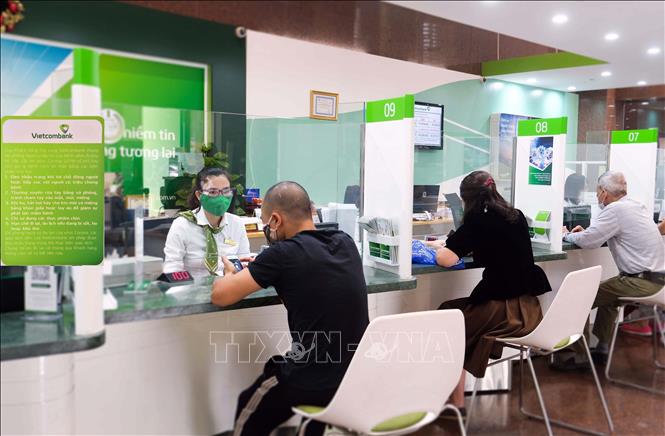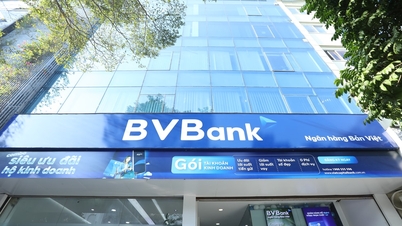As credit flows are unblocked and profits maintain their recovery momentum, advances in risk management, debt handling and coverage ratio enhancement are helping to brighten the financial picture of many banks towards the end of the year.

Positive movement
Bad debt pressure used to be a big test for banks’ management ability, but the picture is now brighter. Thanks to credit restructuring and increased risk provisions, many banks, especially mid-sized and small banks, are recording clear signs of improvement in asset quality.
At Nam A Commercial Joint Stock Bank (Nam A Bank), total assets as of the end of September 2025 reached more than VND 377,000 billion, an increase of more than VND 132,000 billion compared to the beginning of the year. The bad debt ratio decreased from 2.85% at the end of June 2025 to 2.53% (before CIC) and 2.73% (after CIC), while the bad debt coverage ratio (LLR) increased sharply from 39% to nearly 46%. The liquidity reserve ratio reached nearly 20%, double the minimum level prescribed by the State Bank, reflecting prudent risk management capacity.
An Binh Commercial Joint Stock Bank (ABBank) also recorded a clear change. Bad debt balance decreased by 23% to VND2,830 billion; bad debt ratio from 3.74% to 2.63%. In the first 9 months, the bank collected VND282 billion from processed debt, up 21% over the same period, thanks to the active debt collection process in the past two years.
Kienlong Commercial Joint Stock Bank (KienlongBank) has maintained a bad debt ratio below 2% and a bad debt coverage ratio above 80% for three consecutive quarters, among the highest in the industry.
Meanwhile, VietABank recorded a 46% increase in pre-tax profit in the third quarter compared to the same period, reaching VND336 billion; the accumulated profit in the first 9 months reached VND1,050 billion, up 32%. Bad debt increased to VND1,556 billion, equivalent to 1.79%, still within the safe threshold according to the regulations of the State Bank.
Vietnam Prosperity Joint Stock Commercial Bank ( VPBank ) continues to control well by bringing the consolidated bad debt ratio down to below 3%, individual bad debt at 2.23%. Debt recovery reached nearly 2,900 billion VND, up nearly 30% compared to the previous quarter. The consolidated capital adequacy ratio (CAR) remained above 13%, among the highest in the system.
Some other banks such as Loc Phat Commercial Joint Stock Bank ( LPBank ) or Military Commercial Joint Stock Bank (MB) recorded a slight increase in bad debt, up to 1.79% and 1.87% respectively, but were still within the safe threshold when credit was strongly expanded.
Credit growth reinforces positive outlook
Along with the cooling trend of bad debt, credit activities in the whole system continue to record a strong recovery. By the end of September 2025, credit growth reached 13.4% compared to the end of 2024, the highest level in 5 years and far exceeding the same period last year by 9.11%. Credit expansion is thanks to flexible monetary policy, recovering capital demand and spillover effects from public investment and the private sector.
At the same time, bank profits maintained impressive growth. Vietnam Joint Stock Commercial Bank for Industry and Trade (VietinBank) recorded a 51% increase in pre-tax profit over the same period; VPBank increased by 47%; Southeast Asia Commercial Joint Stock Bank (SeABank) by nearly 50%, exceeding the annual plan after only three quarters.
Many banks achieved an increase of over 35% such as Saigon Thuong Tin Commercial Joint Stock Bank (Sacombank), Saigon - Hanoi Commercial Joint Stock Bank (SHB). Notably, ABBank led the system in profit growth with an increase of 872%; Ban Viet Commercial Joint Stock Bank (BVBank) increased by 140%; KienlongBank increased by 102% and Bao Viet Commercial Joint Stock Bank (BaoVietBank) increased by 81%.
Profit growth far exceeded the average of 10-20% in previous years, showing that management efficiency and credit quality have improved significantly, despite net interest margin (NIM) still being under pressure to narrow.
Expectations of bad debt reduction by year-end
According to a survey by the Department of Forecasting, Statistics and Financial Monetary Stabilization (State Bank), most credit institutions assessed that the overall risk of customers tended to decrease in the fourth quarter of 2025. Notably, the proportion of institutions assessing the risk at the "high" or "quite high" level has decreased sharply compared to the previous survey.
Credit institutions also adjusted down their forecasts for the ratio of bad debt to outstanding credit by the end of the year, and expected bad debt to decrease more sharply in the last quarter of the year, contrary to the "increasing" trend of the same period last year. About 70-78% of credit institutions believe that internal and objective factors are moving in the same positive direction, supporting business results and credit quality.
Thus, in the context of accelerating credit, abundant liquidity and positive profits, the expectation of controlling bad debt in the whole industry by the end of 2025 is completely reasonable. Although the differentiation between banks still exists, the general trend is clear, bad debt is being "anchored" more firmly, covered better and moving to a safer area, creating a solid foundation for the banking system to enter 2026 with a more stable and sustainable outlook.
Source: https://baotintuc.vn/kinh-te/tin-hieu-tich-cuc-trong-kiem-soat-no-xau-20251102092518893.htm



![[Photo] The road connecting Dong Nai with Ho Chi Minh City is still unfinished after 5 years of construction.](https://vphoto.vietnam.vn/thumb/1200x675/vietnam/resource/IMAGE/2025/11/04/1762241675985_ndo_br_dji-20251104104418-0635-d-resize-1295-jpg.webp)

![[Photo] Ho Chi Minh City Youth Take Action for a Cleaner Environment](https://vphoto.vietnam.vn/thumb/1200x675/vietnam/resource/IMAGE/2025/11/04/1762233574890_550816358-1108586934787014-6430522970717297480-n-1-jpg.webp)
![[Photo] Panorama of the Patriotic Emulation Congress of Nhan Dan Newspaper for the period 2025-2030](https://vphoto.vietnam.vn/thumb/1200x675/vietnam/resource/IMAGE/2025/11/04/1762252775462_ndo_br_dhthiduayeuncbaond-6125-jpg.webp)
![[Photo] Ca Mau "struggling" to cope with the highest tide of the year, forecast to exceed alert level 3](https://vphoto.vietnam.vn/thumb/1200x675/vietnam/resource/IMAGE/2025/11/04/1762235371445_ndo_br_trieu-cuong-2-6486-jpg.webp)

































































































Comment (0)